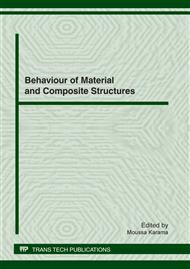[1]
Bhuyan GS, Webster CTL (1997). Fracture performance of NGV cylinder designs. Project report, Powertech Laboratory Inc., 12388-88th Avenue, Surrey, BC Vancouver, V3W 7R7 Canada.
Google Scholar
[2]
Pluvinage G. Fracture and fatigue emanating from stress concentrators. Dordrecht: Kluwer; (2003).
Google Scholar
[3]
Irwin JR. Limitations to the-scale yielding approximation for crack-tip plasticity. J. M Sol, 22, 17-26, (1974).
Google Scholar
[4]
Creager M, Paris PC, Elastic field equations for blunt cracks with reference to stress corrosion cracking. Int J. Fract, 3: 247–52, (1967).
DOI: 10.1007/bf00182890
Google Scholar
[5]
Panasuyk VV, Ivanytska GS, Ostash OP. A new approach to the determination of the macrocrack nucleation period near a stress concentrator. Fatigue and Fracture of Engineering Materials and Structures ; 16(4): 453-64, (1993).
DOI: 10.1111/j.1460-2695.1993.tb00100.x
Google Scholar
[6]
Nakamura T, Parks DM, Determination of elastic T -stress along three-dimensional crack fronts using an interaction integral. Int. J. Solids Struct. 29: 1597 . 611, (1991).
DOI: 10.1016/0020-7683(92)90011-h
Google Scholar
[7]
Bilby BA, Cardew GE, Goldthorpe MR, Howard IC. A, Finite element investigation of the effect of specimen geometry on the fields of stress and strain at the tips of stationary cracks. In: Size effects in fracture. London: Mechanical Engineering Publications Limited. p: 37-46, (1986).
Google Scholar
[8]
Betegon C, Hancock JW, Two-parameter characterization of elastic . plastic crack tip fields. ASME J Appl Mech. 58: 104 . 10, (1991).
DOI: 10.1115/1.2897135
Google Scholar
[9]
Du ZZ, Hancock JW, The effect of non-singular stresses on crack tip constraint. J. Mech. Phys. Solids. 39: 555-67, (1991).
Google Scholar
[10]
Fett, T, T -stresses for components with one-dimensional cracks. Report FZKA 6170, Forschungs-zentrum Karlsruhe, (1998).
Google Scholar
[11]
Williams JG, Ewing PD, Fracture under complex stress—the angled crack problem. Int J Fract; 8(4): 416–41, (1972).
DOI: 10.1007/bf00191106
Google Scholar
[12]
Ueda Y, Ikeda K, Yao T, Aoki, Characteristics of brittle failure under general combined modes including those under bi-axial tensile loads. Eng Fract Mech; 18(6): 1131–58, (1983).
DOI: 10.1016/0013-7944(83)90007-3
Google Scholar
[13]
Smith DJ, Ayatollahi MR, Pavier MJ, The role of T-stress in brittle fracture for linear elastic materials under mixed-mode loading. Fatigue Fract Eng Mater Struct; 24(2): 137–50, (2001).
DOI: 10.1046/j.1460-2695.2001.00377.x
Google Scholar
[14]
Cotterell, B. and Rice, J.R., Slightly curved or kinked cracks. International Journal of Fracture 16, 155–169, (1980).
DOI: 10.1007/bf00012619
Google Scholar
[15]
Du, Z.Z., Betegon, C. and Hancock, J.W. J-dominance in mixed mode loading. International Journal of Fracture 52, 191–206, (1991).
Google Scholar
[16]
O'Dowd, N.P. and Shih, C.F., Family of crack tip fields characterized by a triaxiality parameter-I. Structure of fields. Journal of Mechanics and Physics of Solids 39, 989–1015, (1991).
DOI: 10.1016/0022-5096(91)90049-t
Google Scholar
[17]
Larsson, S. G and Carlsson, A.J., Influence of non-singular stress terms and specimen geometry on small-scale yielding at crack tips in elastic-plastic materials. J. Mech. Phys. Solids 21, 263-278, (1973).
DOI: 10.1016/0022-5096(73)90024-0
Google Scholar
[18]
Rice JR., Limitations to the-scale yielding approximation for crack-tip plasticity. J.M. Solds, 22, 17-26, (1974).
Google Scholar
[19]
Kirk, M.T., Koppenhoefer, K.C. and Shih, C.F., Effect of constraint on specimen dimensions needed to obtain structurally relevant toughness measures. Constraint in Fracture, ASTM STP 1171 (Edited by E.M. Hachett, K. -H. Schwalbe and R.H. Dodds), American Society for testing and Materials, Philadelphia, 79-103, (1993).
DOI: 10.1520/stp18024s
Google Scholar
[20]
Sorem, W.A., Dodds, R.H. and Rolfe, S.T., Effects of crack depth on elastic plastic fracture toughness. Int. J. of Fracture 47, 105-126, (1991).
DOI: 10.1007/bf00032572
Google Scholar
[21]
Hancock, J. W, Reuter, W. G and Parks, D.M., Constraint and toughness parameterized by T. constraint effects in Fracture, ASTM STP 1171 (Edited by E.M. Hackett, K. -H. Schwalbe and R.H. Dodds), American Society for Testing and Materials, Philadelphia, 21-40, (1993).
DOI: 10.1520/stp18021s
Google Scholar
[22]
Sumpter, J.D. S (1993).
Google Scholar
[23]
Ganti and Parks DM (1997). Elastic-plastic fracture mechanics of strength-mismatch interface cracks. In: Mahudhara RK et al., editors. Recent advances in fracture. London, p.13 . 25.
Google Scholar
[24]
Zhang ZL, Hauge M, Taulow C (1997).
Google Scholar
[25]
Jayadevan, K. R, Thaulow, C, Østby, E, Berg, B, Skallerud, B, Holthe, K, and Nyhus, B. (2005). Structural integrity of pipelines: T-stress by line-spring. Fatigue Fract. Engng. Mater. Struct 28, 467-488.
DOI: 10.1111/j.1460-2695.2005.00889.x
Google Scholar
[26]
Li XF, Xu LR. T-stresses across static crack kinking. J. Appl. Mech, in press.
Google Scholar
[27]
Cast3MTM, (2011), Commissariat à l'énergie atomique CEA.
Google Scholar
[28]
R.S., Peterson (1989), Stress Concentration Factors. John Wiley and Sons, New-York.
Google Scholar
[29]
A. N'Diaye, S. Hariri, G. Pluvinage, Z. Azari . Stress concentration factor analysis for notched welded tubular T-joints" International Journal of Fatigue29, 1554–1570, (2007).
DOI: 10.1016/j.ijfatigue.2006.10.030
Google Scholar
[30]
A. Elhakimi (2006). Etude numérique et expérimentale de la nocivité des défauts dans des coques cylindriques et sphériques sous pression. Thèse de doctorat, Ecole des Mines de Douai, France.
DOI: 10.3166/remn.16.79-101
Google Scholar
[31]
H. MOUSTABCHIR, Z. AZARI, S. HARIRI, I. DMYTRAKH Experimental and numerical study of stress–strain state of pressurised cylindrical shells with external defects, Engineering Failure Analysis, Volume 17, Issue 2, March 2010, pp.506-514.
DOI: 10.1016/j.engfailanal.2009.09.011
Google Scholar
[32]
HADJ Meliani, Z. AZARI, G. PLUVINAGE, J. CAPELLE Gouge assessment for pipes and associated transferability problem, Engineering Failure Analysis, Volume 17, Issue 5, July 2010, Pages 1117-1126.
DOI: 10.1016/j.engfailanal.2010.01.007
Google Scholar
[33]
HADJ MELIANI, Z. AZARI, G. PLUVINAGE, YU.G. MATVIE The Effective T-stress Estimation and Crack Paths Emanating from U-notches, Engineering Fracture Mechanics, Volume 77, Issue 11, July 2010, Pages 1682-1692 ACL163.
DOI: 10.1016/j.engfracmech.2010.03.010
Google Scholar
[34]
Wang X. (2003). Elastic T-stress solutions for semi-elliptical surface cracks in infinite thickness plates. Engng Fract Mech. 70: 731-756.
DOI: 10.1016/s0013-7944(02)00081-4
Google Scholar
[35]
Wang, X, Bell, R (2004). Elastic T-stress solutions for semi-elliptical surface cracks infinite thickness plates subject to non-uniform stress distributions. Engng. Fract. Mech. 71, 1477. 1496.
DOI: 10.1016/s0013-7944(03)00140-1
Google Scholar


